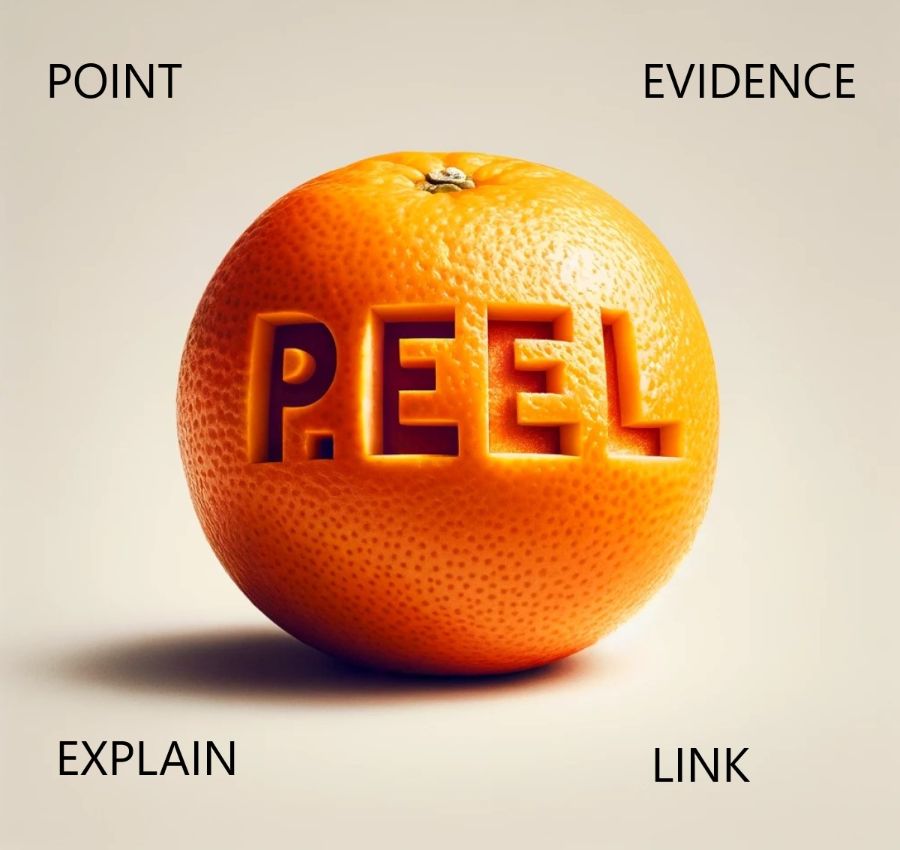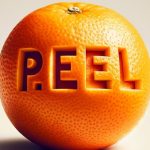Peel paragraphs are largely associated with essay writing, and teachers today are keen to integrate these learning methods into school, college, and even university students to ensure that they know how to formulate essay paragraphs correctly. In this article, you will find the ultimate guide to P.E.E.L. paragraphs, explaining what does PEEL stand for, and how you can properly structure your essays around this format so that you can get your best achievable grade.
What is a PEEL Paragraph?
P.E.E.L. is more than just an acronym; it’s a mnemonic device that can transform your writing abilities. This method can help those to better structure paragraphs to be centred on a single compelling argument.
What does PEEL stand for?
Let’s break down P.E.E.L. and by understanding what each letter stands for will help you to structure your essay arguments professionally so that you can follow your argument better as well as your assessor.

P = Point:
Every argument has to begin with a Point. Start your first paragraph with a robust topic sentence that sets the stage for your argument. Your Point should align seamlessly with your essay’s overarching thesis or argument.
For instance, consider this example: “Fast food advertising plays a significant role in contributing to childhood obesity rates.” This also acts as a hook to catch your readers’ attention. At the same time, this hook, or point, should not be overly long; keep it simple and to the point. Doing it this way will make it easier for you to follow and will ensure that you are not juggling too many balls at once when constructing your argument.

E = Evidence/Example:
The Evidence/Example will build further upon your initial Point, adding more substance into the mix. Here, you will need one or more pieces of evidence to justify your point.
Your Example can take various forms—a quote, an image, a gripping film scene, and more. Choose an example that will particularly stand out, ones that your peers may not have thought of.
But don’t let your Example hang in isolation; provide context. A brief sentence or a few words about the broader plot or context behind the quote elevates your engagement with the text.
Consider this Example: a study published in the American Journal of Pediatrics found that children exposed to frequent fast food advertising on television were more likely to consume high-calorie, low-nutrient foods, leading to weight gain and increased risks of childhood obesity.
As you can see, this example follows the “Point” in the first paragraph. It provides concrete evidence to support the point made in the paragraph’s opening sentence. The evidence is specific and refers to a study published in a reputable journal, demonstrating how exposure to fast food advertising can lead to poor dietary choices among children, ultimately contributing to childhood obesity. This evidence strengthens the argument presented in the paragraph.
Delve deeper into literary analysis with our comprehensive English Literature course

E = Explain:
Now that we’ve presented our Example, it’s time to learn about the second “E” of PEEL paragraphs —Explain. This is where your analysis is important towards defining your overall argument, as to why you chose that particular example, and how it relates more to your point and example. Many people here may be tempted to reiterate what was said in the original point; however, you need to provide more unique evidence and explain more of your argument that, so far, has been unsaid.
Following on from the example about fast food, here is an explanation that adds more detail to that argument: Constant exposure to fast food ads creates a sense of desire among children, leading to a higher consumption of unhealthy foods, which adds to the increased risk of obesity-related health issues.
This Explanation serves the purpose of PEEL paragraphs by offering a thorough understanding of how the Example reinforces the original Point. However, in your argument, you may need to provide one or more paragraphs in your explanation depending on how detailed that you want your argument to be. So long as you structure your argument evenly, and do not lose sight of the overall narrative, you are offering further insights into your argument without losing the attention or confusing the reader.

L = Link:
As we draw this P.E.E.L. paragraph explanation to a close, it’s time to address the final letter—L, which stands for Link. This critical step ensures your paragraph cohesively ties together and, more importantly, links back to your essay’s central question, topic, or thesis.
The Link serves to wrap up your argument, making it clear and organised. However, it’s important to remember that the Link shouldn’t be a repetition of your Point; it should conclude your argument evenly without repeating what has already been said.
Here is an example of a Link to our argument: To conclude, the evidence suggests that fast food advertising indeed plays a significant role in shaping the dietary habits of children, ultimately contributing to the concerning rise in childhood obesity rates. Our initial Point, which highlighted the impact of fast food advertising, is now reinforced by the concrete Example of the study from the American Journal of Pediatrics. Through the Explanation, we uncovered the intricate mechanisms at play, solidifying the connection between advertising exposure and unhealthy food choices.
This Link encapsulates the essence of PEEL paragraphs by summarising the Point, demonstrating how the Example supports it, and reiterating the importance of this relationship. Whilst we added the ‘Point,’ ‘Example,’ and ‘Explanation’ within this text, this was merely as reference to you to easily follow this argument, and how you should initially format it when it comes to writing your assessment.
Learn P.E.E.L and much more
Improve your speaking, writing, or comprehension, we have the perfect course for you
Online English CoursesPracticing PEEL paragraphs:
Let’s put the PEEL structure into practice with a fresh example:
Topic: Should public transportation be free in metropolitan areas?
Thesis/Argument: Public transportation should be made free in metropolitan areas to reduce traffic congestion and promote environmental sustainability.
Point: Public transportation in metropolitan areas should be provided for free as it can alleviate traffic congestion and reduce the environmental footprint caused by excessive car usage.
Evidence/Example: A recent study conducted in major metropolitan cities across the world, including New York and London, demonstrated that when public transportation was made free during designated hours, there was a noticeable decrease in traffic congestion during those times. The study’s data revealed a 20% reduction in traffic volume during the morning and evening rush hours.
Explanation: The reason behind this reduction in traffic congestion is clear. When individuals are offered a convenient and cost-free alternative to driving their own vehicles, they are more likely to choose public transportation. This not only eases the burden on roads but also diminishes the emissions from numerous vehicles, contributing to a greener and more sustainable urban environment.
Link: In summation, this example underscores the potential benefits of making public transportation free during peak hours in metropolitan areas. It aligns with the broader argument that free public transportation can lead to reduced traffic congestion and a more eco-friendly urban landscape. As we explore the practical application of the P.E.E.L structure, it becomes evident that this method equips us with a powerful tool for crafting persuasive essays.
Each element – Point, Evidence/Example, Explanation, and Link – plays a distinct role in advancing your argument. And don’t forget the importance of proofreading to ensure your paragraph flows smoothly, to truly convey your message effectively.
And if you are having problems with your writing, here is how you can understand the four main writing styles.
Adopt The Ultimate P.E.E.L. Paragraph Method
And that is how you can use the PEEL paragraph method for your essay. From understanding its mnemonic origin to breaking down each component—Point, Evidence/Example, Explanation, and Link—we’ve equipped you with the skills to craft compelling paragraphs. Whether you’re an English High-Level Teaching Assistant (HLTA) aspirant or a student aiming to elevate your writing, the P.E.E.L. method offers a roadmap to clarity, coherence, and persuasive prowess in your essays.
Having this knowledge will be especially helpful for those learning about becoming a teaching assistant. You can also find more helpful knowledge in our education section.
FAQs
How to do evidence in a peel paragraph?
To include evidence in PEEL paragraphs, select relevant and compelling examples or data that support your point. Ensure the evidence is well-contextualised and directly related to your argument.
How do you teach peel writing?
Teaching P.E.E.L. writing involves explaining each element (Point, Evidence/Example, Explanation, Link), providing examples, and practicing together. Encourage students to apply the structure in their writing assignments to enhance their skills.
Sources
Indeed Editorial Team. (2023) Understanding the four main writing styles. Indeed. [online] available at: https://uk.indeed.com/career-advice/career-development/writing-styles [accessed 24/11/23]








